Business Automation
12 Best Small Business Automation Tools (2025 Guide)
Discover the 12 best small business automation tools to streamline workflows, save time, and boost efficiency. Compare top platforms like Zapier, HubSpot, and Make.
TL;DR — Quick Takeaways
- Small business automation tools streamline daily tasks like marketing, sales, and data entry without coding.
- Top tools include Zapier, HubSpot, Make, and Shopify Flow for their powerful integrations.
- Start small by automating repetitive, high-impact processes and scale as your workflow matures.
- Balance automation with human expertise for customer-facing roles — the best growth strategy is hybrid.
Are you spending too much time on repetitive tasks that pull you away from growing your business? Small business owners often wear multiple hats, but manual data entry, follow-up emails, and social media updates can consume valuable hours. The good news is that you no longer need a massive budget or an in-house IT department to reclaim your time. The right small business automation tools can streamline your operations, reduce errors, and free you up to focus on what truly matters: your customers and your strategy.
As automation continues to evolve, many businesses are also leveraging artificial intelligence to further enhance efficiency. For those looking to take the next step, you can discover more about the best AI tools for small business to see how intelligent systems can complement your automation efforts. Our focus here, however, is on the foundational tools that set the stage for scalable growth. Let’s find the perfect fit for your operations.
1. Zapier
Zapier is a dominant player among small business automation tools, acting as a universal translator between thousands of different web applications. Its core strength lies in its “if this, then that” logic, allowing you to build automated workflows, or “Zaps,” without writing a single line of code. For instance, a small e-commerce business can automatically add a new Shopify customer to a Mailchimp email list and simultaneously create a task in Asana for the fulfillment team.

This platform stands out due to its vast integration library, boasting over 6,000 apps, which is more than most competitors. Its intuitive visual builder makes creating complex, multi-step Zaps accessible even for non-technical users. If you’re starting to explore how to automate repetitive tasks, Zapier is an excellent starting point.
Key Details & Pricing
- Ideal For: Businesses needing to connect a wide variety of SaaS tools without IT support.
- Pros: Massive integration library, user-friendly interface, strong community and template resources.
- Cons: Costs can escalate quickly with high task volume, and a past security incident required users to rotate API keys.
- Pricing: Offers a free tier for basic, single-step Zaps. Paid plans start at $19.99/month (billed annually) for multi-step Zaps and more tasks.
Visit the website: https://zapier.com/l/agents-pricing
2. Make (formerly Integromat)
Make, formerly known as Integromat, is a powerful visual automation platform that excels where complex logic and data manipulation are required. It allows users to build intricate workflows, or “scenarios,” using a drag-and-drop interface that visualizes the entire process. A small business could use Make to create a scenario that automatically pulls new leads from a Facebook Lead Ad, enriches the data with an external API, and then branches the flow: high-value leads are added to a CRM like Salesforce, while others are sent to a nurturing sequence in an email marketing tool.

This platform stands out by giving users granular control over their automations. Features like routers for creating conditional paths and detailed error-handling modules make it one of the more robust small business automation tools for technical users or agencies managing client workflows. Its execution logs and ability to replay scenario runs are invaluable for debugging complex automations. While it has a steeper learning curve than some alternatives, its powerful capabilities and competitive pricing model make it a compelling choice for businesses that need to go beyond simple “if-then” connections.
Key Details & Pricing
- Ideal For: Businesses and agencies that require complex, multi-path workflows and fine-grained control over data manipulation.
- Pros: Generous features at lower price points, excellent for complex flows with branching logic, detailed debugging and logging capabilities.
- Cons: The operations-based credit system can be confusing for new users, and its visual interface can feel less intuitive than simpler tools.
- Pricing: Offers a generous free tier. Paid plans start at $9/month (billed annually), providing more operations and faster scheduling.
Visit the website: https://www.make.com/en/pricing
3. Microsoft Power Automate
Microsoft Power Automate is a powerful automation service that excels for businesses deeply integrated into the Microsoft 365 ecosystem. It goes beyond simple “if this, then that” workflows by offering both cloud-based automation (Power Automate Flows) and desktop-based robotic process automation (RPA) for legacy systems. A small business can use it to automatically save email attachments from Outlook to a specific SharePoint folder, post a message in Teams, and then log the action in an Excel spreadsheet.
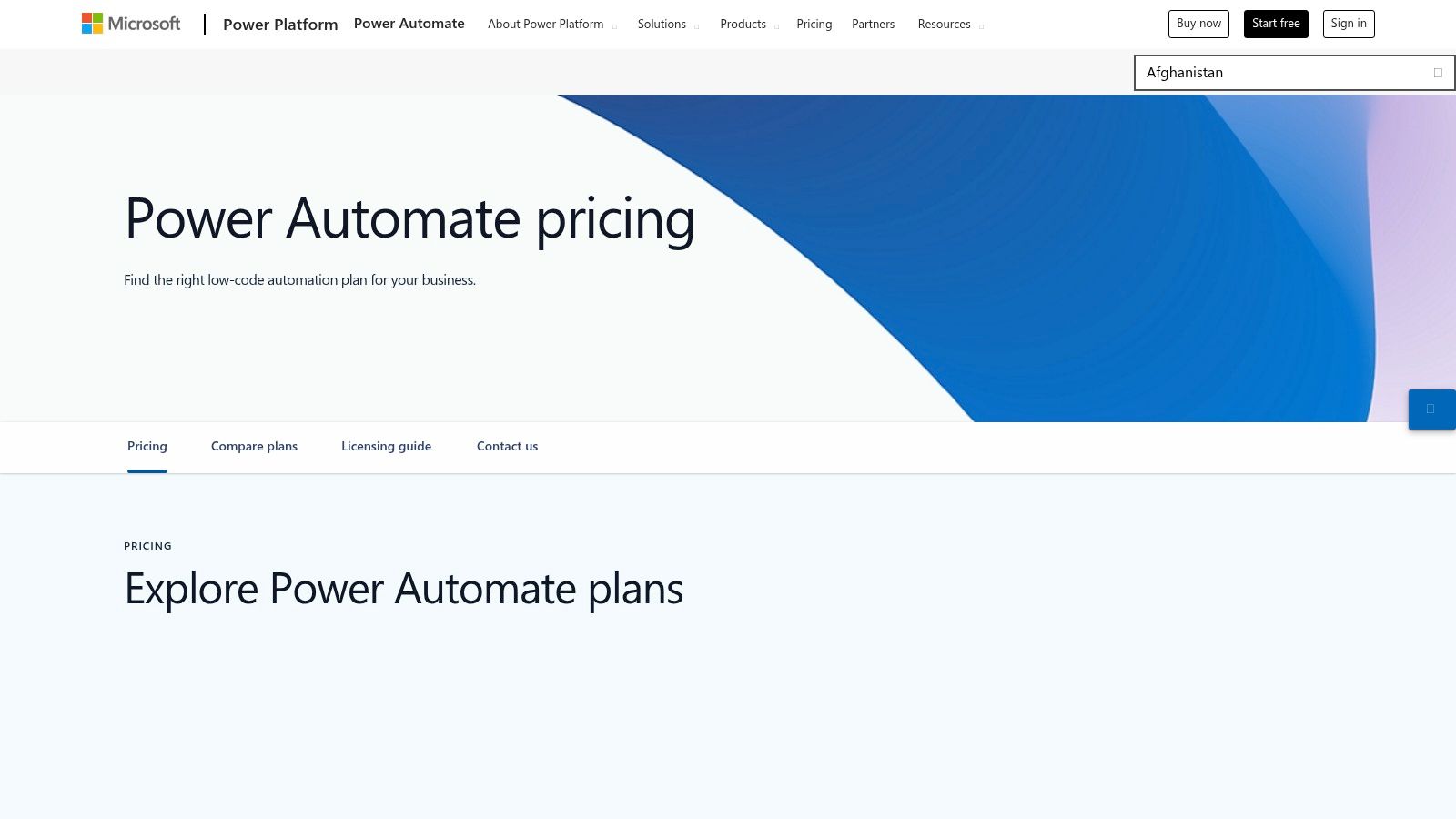
This platform stands out by bridging the gap between modern cloud apps and older, on-premise software through its attended and unattended bots. While its connection library is smaller than some competitors, its native integration with tools like SharePoint, Teams, and Dynamics 365 is seamless and robust. For companies leveraging the Microsoft stack, Power Automate is one of the most cohesive small business automation tools available, offering a unified environment for managing workflows. These capabilities are increasingly important in customer service, and you can learn more about automation in call centers.
Key Details & Pricing
- Ideal For: SMBs already invested in the Microsoft 365 ecosystem needing both cloud and desktop automation.
- Pros: Deep integration with Microsoft 365 and Teams, scales from simple flows to enterprise RPA scenarios.
- Cons: Licensing can be complex, and costs for premium connectors and RPA bots can add up significantly.
- Pricing: Limited free use is included with many Microsoft 365 plans. Premium plans start at $15 per user/month for unlimited flows.
Visit the website: https://www.microsoft.com/en/power-platform/products/power-automate/pricing
4. HubSpot Marketing Hub
HubSpot Marketing Hub goes beyond simple task connection by offering an all-in-one platform where marketing automation and a customer relationship management (CRM) system are deeply integrated. This unified approach allows small businesses to manage the entire customer journey, from attracting leads with automated social media scheduling and ad campaigns to nurturing them through personalized email workflows. For example, a user who downloads an ebook can be automatically enrolled in a follow-up email sequence, with their engagement tracked directly in their CRM profile.
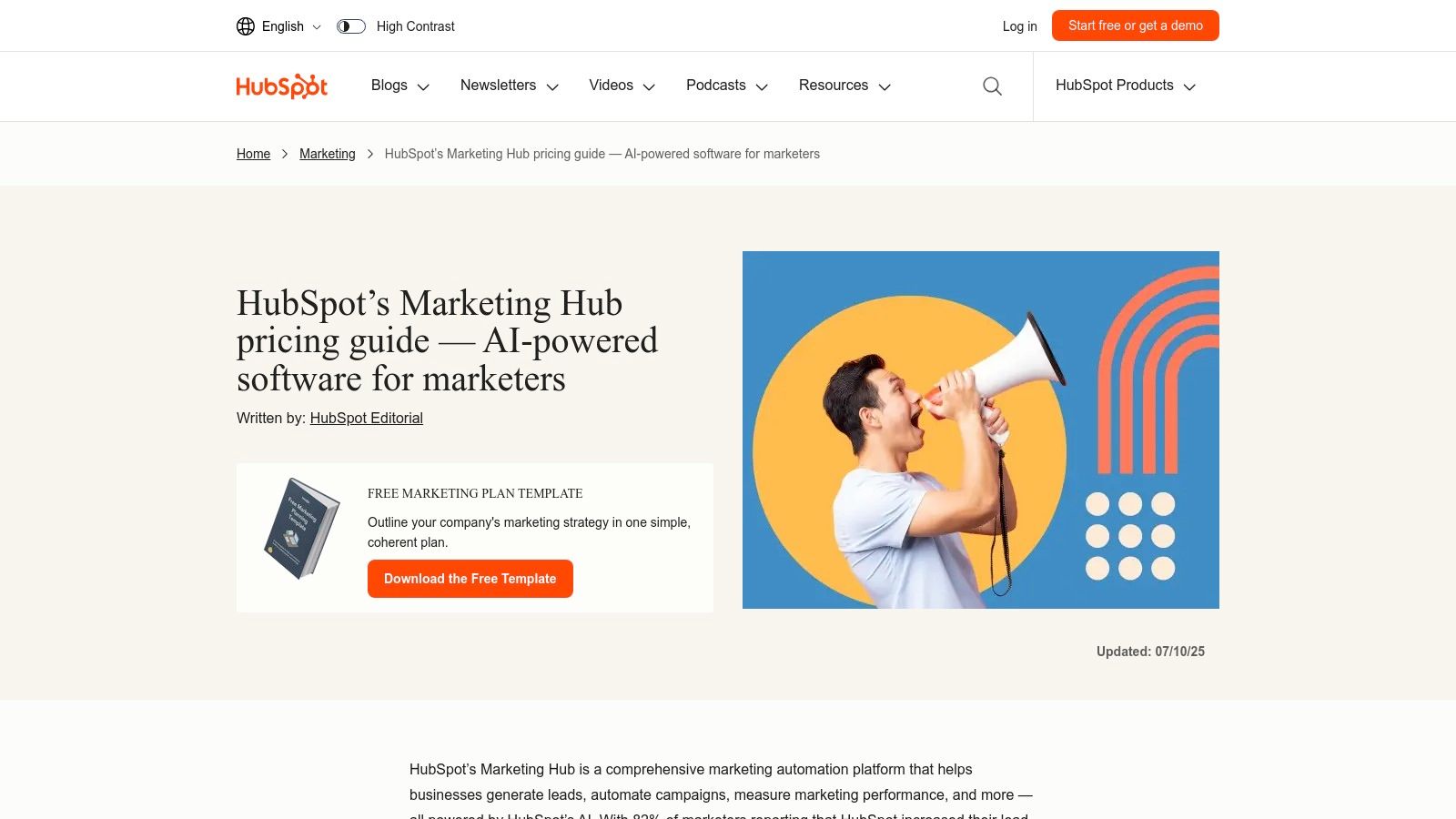
What sets HubSpot apart is its powerful combination of accessibility and scalability. The visual workflow builder makes it easy to create sophisticated automation rules based on lead behavior, segmentation, and lead scoring without needing a developer. As a business grows, the platform scales with it, offering more advanced features. Among small business automation tools, HubSpot excels at providing an end-to-end solution that connects marketing efforts directly to sales results, all within a single ecosystem supported by extensive educational resources.
Key Details & Pricing
- Ideal For: Businesses seeking a unified CRM and marketing automation platform to manage the full customer lifecycle.
- Pros: Tightly integrated CRM and marketing tools, excellent onboarding and support resources, highly scalable.
- Cons: Higher-tier plans can be costly with potential onboarding fees, and contacts-based pricing requires diligent list management.
- Pricing: Offers a range of free tools. Paid plans start at $18/month (billed annually), with Professional and Enterprise tiers available for advanced automation.
Visit the website: https://blog.hubspot.com/marketing/hubspot-marketing-hub-pricing
5. Mailchimp
Mailchimp is a cornerstone of email marketing automation, known for making sophisticated campaigns accessible to businesses of all sizes. It excels at creating automated “customer journeys,” allowing you to send targeted welcome emails, abandoned cart reminders, or re-engagement campaigns based on user behavior. A retail business, for example, can automatically send a discount code to a customer who hasn’t purchased in 90 days, all without manual intervention.
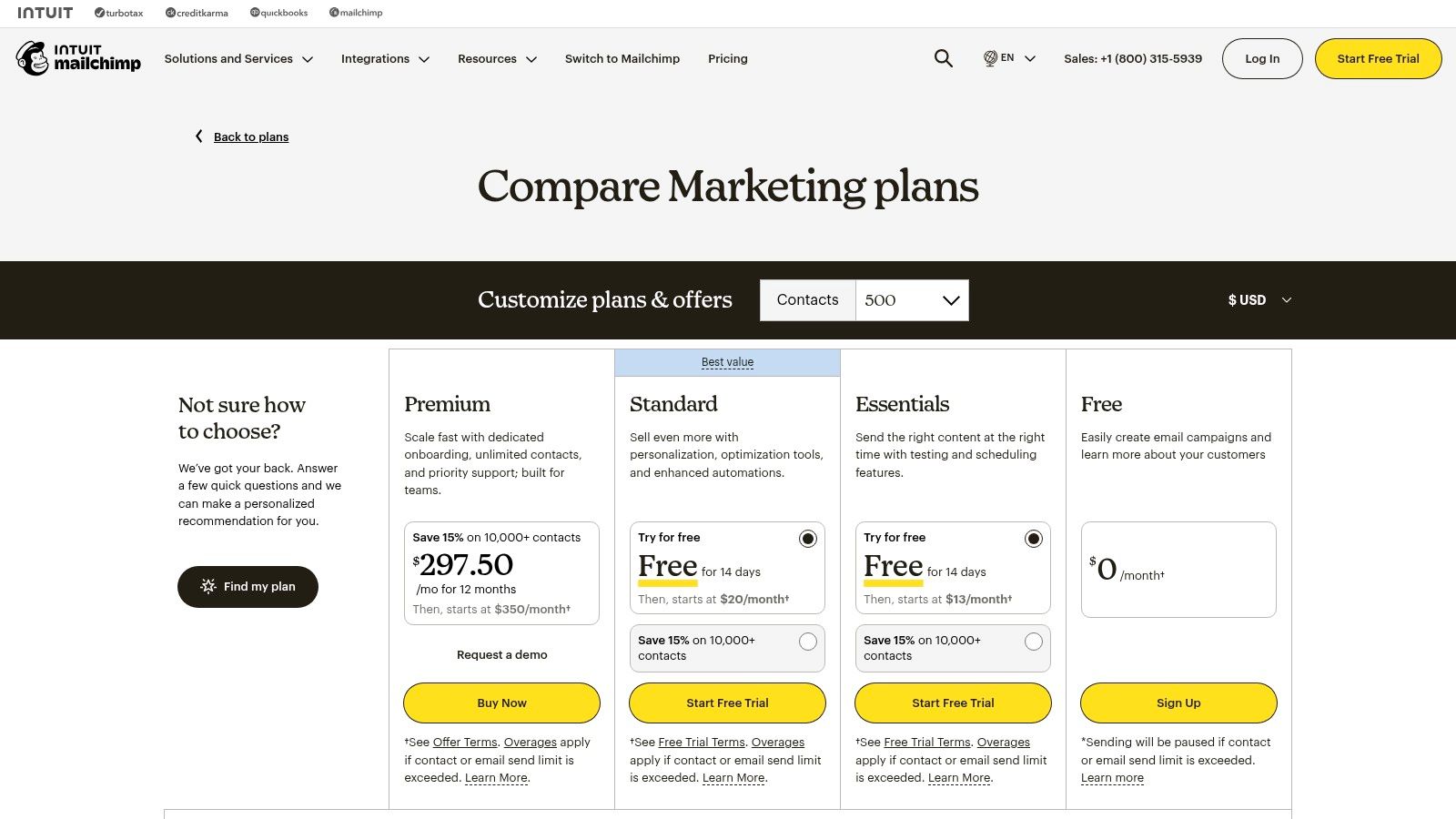
The platform stands out with its user-friendly interface, pre-built journey templates, and deep e-commerce integrations with platforms like Shopify and WooCommerce. This makes it one of the most popular small business automation tools for those focused on marketing. While its core function is email, it also offers add-ons for SMS and social media campaigns. For businesses looking to scale their marketing efforts efficiently, delegating campaign management to a specialist can be a powerful strategy; you can discover how a virtual assistant can help with tasks like these.
Key Details & Pricing
- Ideal For: E-commerce stores and small businesses launching their first email marketing and automation programs.
- Pros: Easy to launch and use with a large template/integration library, clear pricing tiers and a generous free plan for validation.
- Cons: Costs increase significantly as contact lists and send volumes grow, and advanced features are gated to higher-tier plans.
- Pricing: Offers a free tier for up to 500 contacts and 1,000 monthly sends. Paid plans start at $13/month for more features and higher limits.
Visit the website: https://mailchimp.com/pricing/free-details/
6. ActiveCampaign
ActiveCampaign transcends standard email marketing by offering a powerful suite of marketing automation tools paired with a lightweight CRM. It’s designed for small businesses that want to create sophisticated, personalized customer journeys. For example, a business can automatically tag a contact who clicks a specific link in an email, add them to a sales pipeline, and then trigger a follow-up SMS message from a salesperson, all within a single automated workflow.
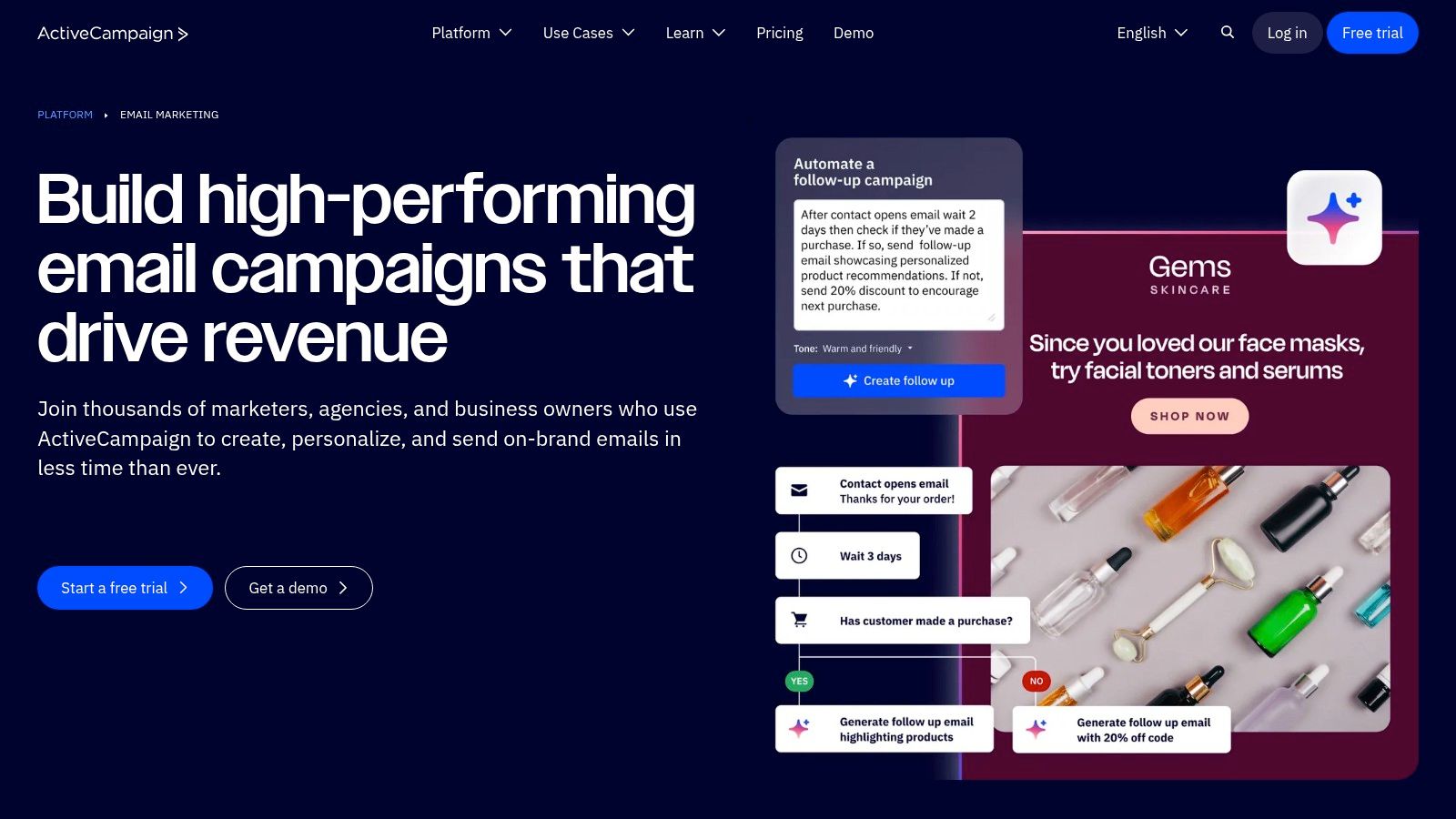
What sets ActiveCampaign apart is its focus on advanced automation logic, such as split paths, goal tracking, and lead scoring, which are often found in more expensive enterprise platforms. The platform’s visual workflow builder makes these complex sequences manageable. With over 900 integrations and robust multichannel messaging capabilities (email, SMS, WhatsApp), it stands as a comprehensive solution among small business automation tools for nurturing leads from initial contact to conversion and beyond.
Key Details & Pricing
- Ideal For: Businesses wanting to combine advanced marketing automation with sales CRM functionalities.
- Pros: Powerful and flexible automation capabilities, strong email deliverability, and free migration support.
- Cons: Pricing scales with contact count and can become costly, while the interface’s depth may require a learning curve.
- Pricing: Plans start at $29/month (billed annually) for the Marketing Lite package, with prices increasing based on features and number of contacts.
Visit the website: https://www.activecampaign.com/platform/email-marketing
7. Zoho Flow
Zoho Flow is Zoho’s answer to the integration platform market, designed to connect apps and automate complex business workflows. Its biggest advantage lies in its native ecosystem; if your business is already invested in Zoho products like Zoho CRM, Books, or Desk, Flow provides a seamless and powerful automation layer. For instance, you could create a flow where a new lead in Zoho CRM automatically generates an estimate in Zoho Books and assigns a follow-up task in Zoho Projects.
This platform shines for businesses committed to the Zoho suite, offering deeper and more reliable connections than many third-party tools can provide. It features an intuitive, drag-and-drop builder that supports complex logic, including branching conditions and custom functions using Zoho’s own scripting language, Deluge. As a key player among small business automation tools, it empowers users to build sophisticated processes without needing extensive IT resources, bridging the gap between their cloud apps and on-premise systems with its on-prem agent.
Key Details & Pricing
- Ideal For: Companies heavily invested in the Zoho ecosystem seeking deep, native integrations.
- Pros: Highly competitive pricing for high task volumes, powerful native integration with all Zoho applications.
- Cons: The third-party app library is significantly smaller than competitors like Zapier, and certain premium connectors are gated behind higher-tier plans.
- Pricing: A free plan is available. Paid plans start at $10/month (billed annually) for 1,000 tasks and premium app access.
Visit the website: https://www.zoho.com/flow/
8. Shopify Flow
For businesses operating on Shopify, Shopify Flow is an indispensable native automation tool. It empowers merchants to automate tasks and processes directly within their e-commerce ecosystem, eliminating the need for many third-party connectors. Using a simple trigger, condition, and action framework, you can automate workflows for inventory management, order processing, customer segmentation, and fraud prevention. For example, you can automatically tag high-value customers, send a notification when inventory is low, or flag potentially fraudulent orders for review.

What makes Shopify Flow a powerful choice among small business automation tools is its deep, reliable integration with Shopify’s core data. Because it’s a native app, it has direct access to all store events and objects, from orders and products to customer data. This allows for highly specific and dependable automations that external tools might struggle to replicate. Pre-built templates and a visual workflow builder make it accessible, even for those new to automation. Automating these internal processes can free up your team, allowing them to focus on more complex tasks that might benefit from expert customer support for your app.
Key Details & Pricing
- Ideal For: E-commerce businesses running on the Shopify platform.
- Pros: No additional cost on eligible Shopify plans, deep and reliable access to store data, and an easy-to-use visual builder.
- Cons: Exclusively for Shopify stores and may require other tools for complex automations involving non-Shopify apps.
- Pricing: Included free with Shopify, Shopify Plus, Advanced, and Commerce Components plans.
Visit the website: https://help.shopify.com/en/manual/shopify-flow
9. Airtable
Airtable brilliantly blends the simplicity of a spreadsheet with the power of a database, making it a uniquely flexible platform for small business automation tools. It allows businesses to build custom applications for managing everything from content calendars and project timelines to lightweight CRMs and inventory systems. You can create automated workflows directly within your data, such as sending a notification when a project status changes or creating a new record in another table when a form is submitted.
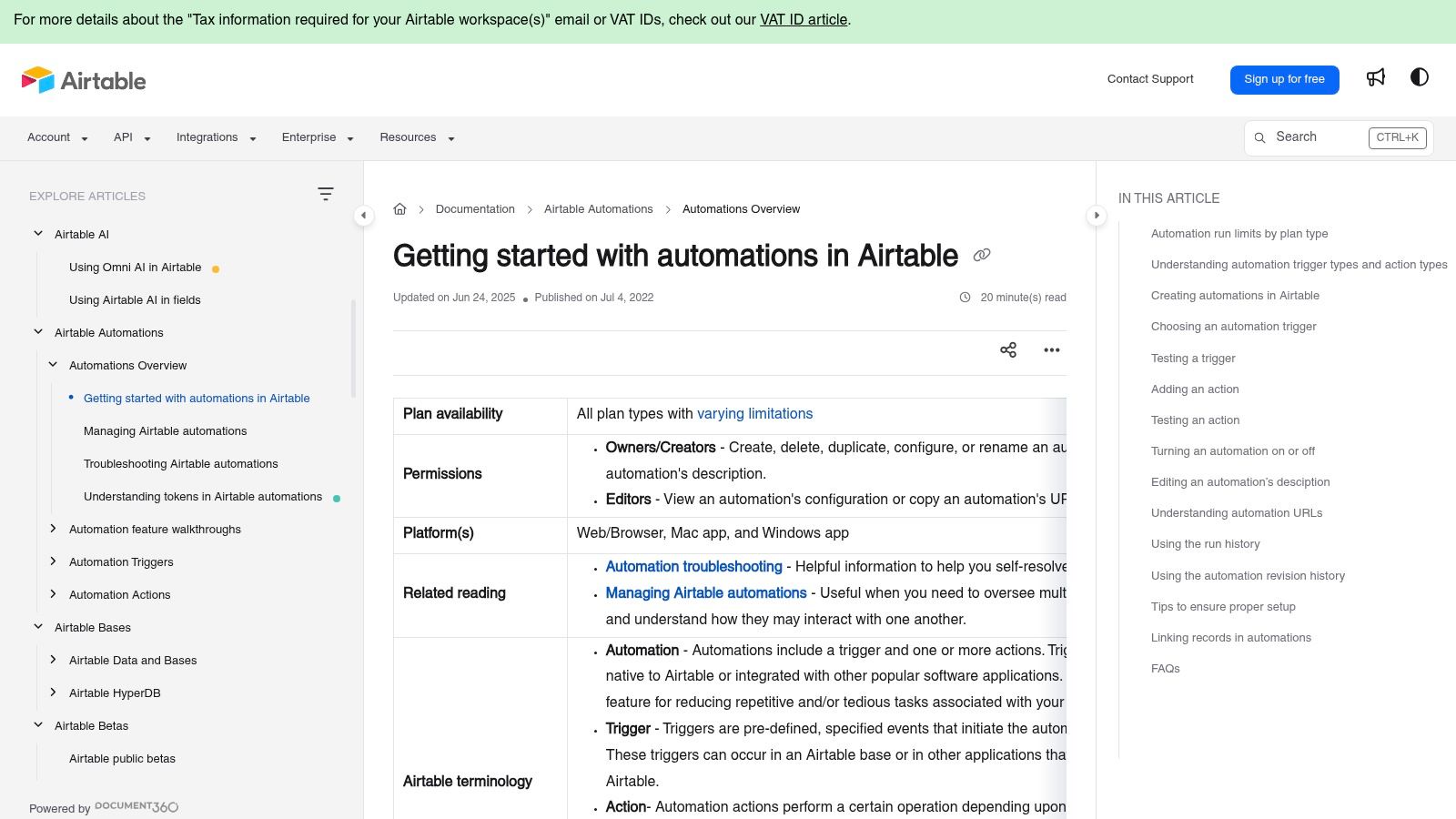
What sets Airtable apart is its visual and highly customizable nature. Users can create “Interfaces” which are user-friendly dashboards that allow team members to interact with data without getting lost in complex tables. For businesses looking to structure operational data, Airtable provides an accessible bridge from chaotic spreadsheets to a more robust, automated system. Its ability to serve as a single source of truth for various operations makes it invaluable, and it can even function as a back-end for certain help desk software solutions.
Key Details & Pricing
- Ideal For: Teams needing a visual way to manage structured data and build custom, internal operational tools.
- Pros: Highly flexible data modeling with a user-friendly interface, bridges the gap between spreadsheets and databases.
- Cons: Automation run limits on the free plan are very restrictive, and building complex relational models requires careful planning.
- Pricing: A free plan is available with core features. Paid plans start at $20 per seat/month (billed annually) for more automation runs, features, and history.
Visit the website: https://support.airtable.com/docs/getting-started-with-airtable-automations
10. Google AppSheet
For businesses deeply embedded in the Google Workspace ecosystem, Google AppSheet provides a seamless way to build custom applications and automate internal processes without writing code. It empowers teams to transform data from sources like Google Sheets or Drive into powerful, mobile-friendly apps for tasks such as inventory management, project tracking, or field service reporting. For example, a construction firm can create an app for on-site workers to log progress photos and notes, which automatically updates a central Google Sheet for the project manager.
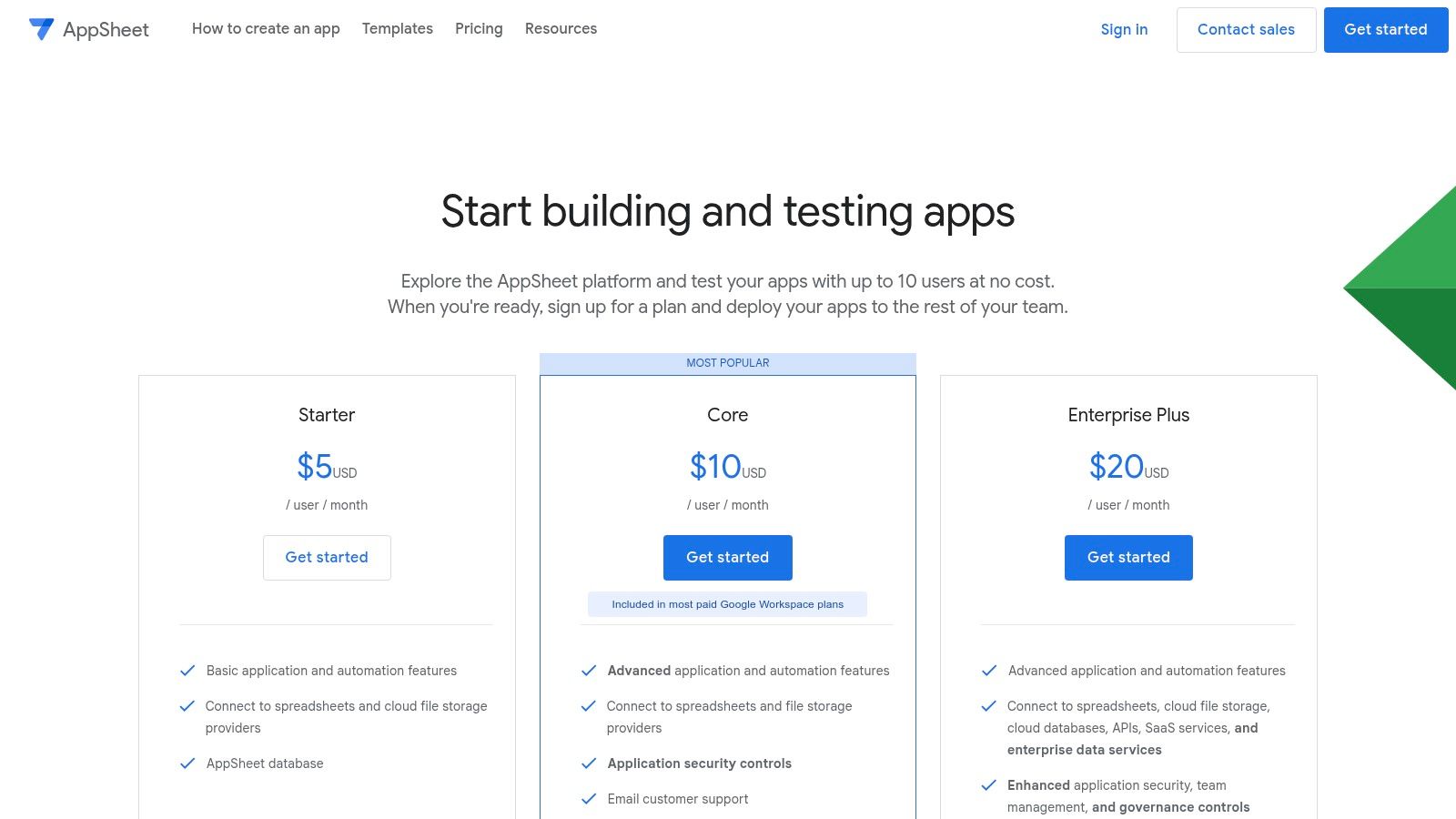
What sets AppSheet apart is its native integration with Google services and its robust offline capabilities, allowing apps to sync data even without a constant internet connection. This platform excels at creating simple, data-driven internal tools, making it one of the most accessible small business automation tools for non-developers. Its automations can trigger emails, push notifications, and SMS alerts based on data changes, streamlining communication and workflows directly from your existing data sources.
Key Details & Pricing
- Ideal For: Teams using Google Workspace who need to build simple, data-driven internal apps quickly.
- Pros: Deep integration with Google Workspace, excellent value with low per-user pricing, strong offline and background sync capabilities.
- Cons: App design flexibility is limited compared to custom development, and advanced connectors require more expensive enterprise-level plans.
- Pricing: Offers a free plan for prototyping with up to 10 users. Paid plans start at $5 per user/month.
Visit the website: https://about.appsheet.com/pricing
11. Pipedrive
Pipedrive is a sales-focused CRM designed with the specific goal of helping small businesses manage their sales pipeline and customer relationships. Where other small business automation tools cast a wide net, Pipedrive zeroes in on automating the sales process itself. It allows you to build workflows that trigger actions based on deal progression, such as automatically assigning tasks to a sales rep when a deal moves to a new stage or sending a personalized follow-up email after a set period of inactivity.
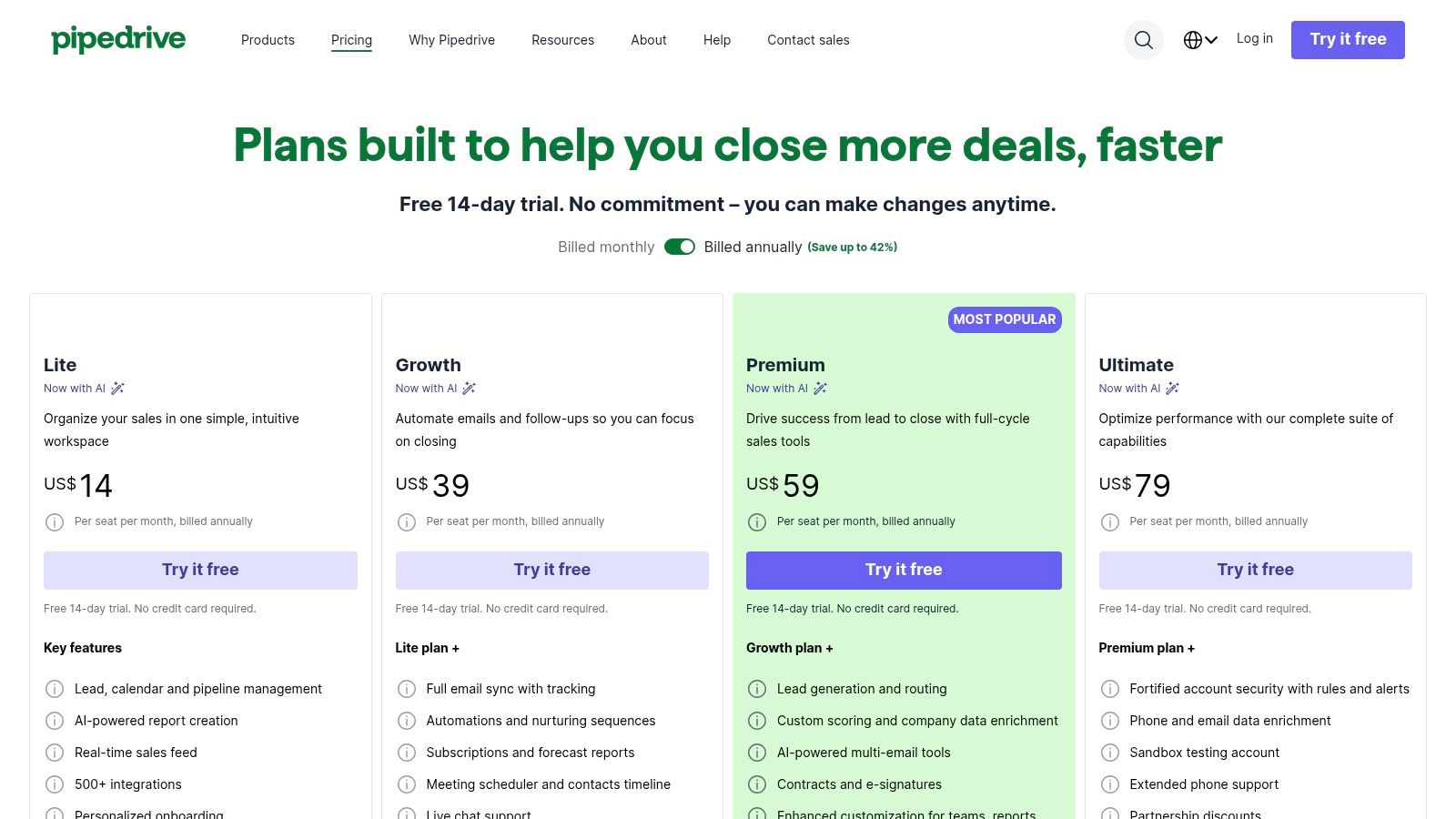
The platform stands out for its simplicity and visual interface, which is built around a clear, drag-and-drop sales pipeline. This sales-first approach makes it incredibly intuitive for sales teams to adopt without extensive training. Instead of getting lost in complex, all-purpose automation builders, users get a tool that is laser-focused on moving leads through the funnel, from initial contact to a closed deal. Its email sync and scheduler features further streamline communication, making it a powerful hub for sales activity.
Key Details & Pricing
- Ideal For: Sales-driven small businesses that need to automate lead management and pipeline activities.
- Pros: Simple, sales-first UI that is fast to implement; clear plan-based automation quotas and predictable limits.
- Cons: Advanced automation features require higher-tier plans; frequency and active-automation limits can restrict heavy use.
- Pricing: Starts with the Essential plan at $14.90/user/month (billed annually). Workflow automation is available on the Advanced plan and up, starting at $27.90/user/month.
Visit the website: https://www.pipedrive.com/en/pricing
12. G2 (Small Business Marketing Automation category)
While not an automation tool itself, G2 is an essential resource for selecting the right software. It’s a vast software marketplace and review platform where you can compare a wide range of small business automation tools side-by-side. Its dedicated category for Small Business Marketing Automation allows you to filter options based on company size, features, and satisfaction ratings, ensuring you find a tool that genuinely fits your operational needs. For example, a retail business can directly compare two email marketing platforms based on verified user reviews concerning deliverability and ease of use.
G2 stands out by aggregating thousands of verified user reviews, providing an unfiltered look at a tool’s real-world performance. The platform’s comparison grids and detailed reports help businesses vet a vendor’s reputation and capabilities before committing to a demo or trial. This due diligence is crucial for making a confident and informed purchasing decision.
Key Details & Pricing
- Ideal For: Businesses in the research phase, looking to compare features, pricing, and user satisfaction across multiple automation vendors.
- Pros: Broad market coverage with fresh user review data, helps vet reputation and fit prior to committing to a vendor.
- Cons: Sponsored placements appear on the site, so always corroborate findings with free trials. G2 is not a vendor, so purchases happen on third-party websites.
- Pricing: Free to use for browsing, comparing, and reading reviews.
Visit the website: https://www.g2.com/categories/marketing-automation/small-business
Top 12 Small Business Automation Tools Comparison
| Product | Core Focus | UX & Rating (★) | Value & Pricing (💰) | Target Audience (👥) | USP (✨/🏆) |
|---|---|---|---|---|---|
| Zapier | No-code workflow automation; 6,000+ integrations | Easy visual builder; mature ecosystem ★★★★ | Fast time-to-value; costs scale with task volume 💰💰 | 👥 SMBs needing broad SaaS connectivity | ✨ Largest integration library; templates & experts |
| Make (Integromat) | Visual scenario builder with strong data manipulation | Powerful, precise flows; steeper learning ★★★★ | Feature-rich at generally lower cost 💰 | 👥 SMBs & agencies needing complex branching | ✨ Fine-grained control, excellent debugging 🏆 |
| Microsoft Power Automate | Cloud + desktop RPA; tight Microsoft 365/Teams integration | Enterprise-grade controls; complex to license ★★★★ | Scales for enterprise; premium connectors add cost 💰💰💰 | 👥 Organizations invested in Microsoft ecosystem | ✨ Attended/unattended RPA + governance 🏆 |
| HubSpot Marketing Hub | CRM + marketing automation (email, landing pages, ads) | Unified UX; strong onboarding & reporting ★★★★ | Free→Enterprise tiers; can be costly at scale 💰💰💰 | 👥 SMBs seeking end-to-end CRM + marketing | ✨ Native CRM + onboarding ecosystem 🏆 |
| Mailchimp | Email marketing & customer journeys; e‑commerce integrations | Very easy to launch; large template library ★★★ | Free tier for small lists; costs rise with contacts 💰 | 👥 Starters & small e-commerce businesses | ✨ Quick setup & ready-made templates |
| ActiveCampaign | Advanced automation + lightweight CRM; multichannel messaging | Deep automation and deliverability focus ★★★★ | Contact-based pricing; scales with list size 💰💰 | 👥 SMBs needing advanced journeys & deliverability | ✨ Multichannel messaging & deliverability 🏆 |
| Zoho Flow | iPaaS for Zoho apps and third‑party integrations | Stable flows; smaller third‑party catalog ★★★ | Competitive task-based pricing 💰 | 👥 Zoho users & cost-conscious SMBs | ✨ Tight Zoho suite integration; Deluge scripting |
| Shopify Flow | Shopify-native automations for orders, customers, inventory | Reliable store event access; store-only scope ★★★★ | Free on eligible Shopify plans 💰 | 👥 Shopify merchants | ✨ Native triggers & templates for store ops 🏆 |
| Airtable | Spreadsheet‑meets‑DB with automations, interfaces | User-friendly for modeling; run caps by plan ★★★★ | Free→paid; automation run limits apply 💰💰 | 👥 Ops, content, projects, lightweight CRM teams | ✨ Visual data model + extensibility |
| Google AppSheet | No-code apps + automations for Google Workspace data | Good for mobile/offline apps; limited design flexibility ★★★ | Low per-user pricing; free prototyping for small teams 💰 | 👥 Google Workspace teams building internal apps | ✨ Offline sync & deep Workspace connectors |
| Pipedrive | Sales CRM with workflow automations for pipeline tasks | Simple sales-first UI; fast to implement ★★★ | Predictable plan quotas; moderate cost 💰 | 👥 Sales-focused SMBs | ✨ Fast-to-implement sales automations |
| G2 (SMB Marketing Automation) | Software marketplace & verified user reviews | Fresh reviews and comparison pages; vendor ads present ★★★★ | Free to browse; sponsored listings exist 💰 | 👥 Buyers shortlisting marketing automation | ✨ Aggregated verified reviews & side-by-side comparisons 🏆 |
Beyond Software: When to Automate with a Human Touch
Navigating the landscape of small business automation tools can feel overwhelming, but the journey from manual processes to streamlined efficiency is a transformative one. As we’ve explored, platforms like Zapier and Make excel at connecting disparate apps, while marketing powerhouses like HubSpot and ActiveCampaign automate customer engagement. Meanwhile, specialized tools such as Shopify Flow and Pipedrive bring targeted automation to e-commerce and sales pipelines, respectively.
Automation isn’t about replacing your team; it’s about empowering them to focus on high-impact activities like strategic planning, creative problem-solving, and building genuine customer relationships.
Your Action Plan for Implementing Small Business Automation Tools
Choosing the right tool is only the first step. To ensure a successful transition, consider this a strategic initiative, not just a software purchase. Start by identifying the most significant bottlenecks in your current workflows. Where do repetitive tasks slow you down? Where do manual errors cost you money or customer trust?
Follow these actionable next steps to make a smart decision:
- Audit Your Processes: Before you can automate, you must understand what you do. Map out key workflows, from lead capture to customer onboarding, and pinpoint the exact steps that can be handled by software.
- Start Small and Scale: Don’t try to automate everything at once. Pick one or two high-impact, low-risk processes to start with. A successful pilot project builds momentum and demonstrates the value of automation to your team.
- Prioritize Integration: The true power of these tools is unleashed when they work together. Ensure your chosen platform integrates seamlessly with the software you already use daily, like your CRM, email marketing service, and accounting software.
The Irreplaceable Value of Human Connection
While technology is a powerful efficiency driver, it’s crucial to recognize its limits. Automation is for processes; relationships are for people. For the critical moments in the customer journey that require empathy, complex problem-solving, or personalized guidance, a human touch is not just better, it’s essential. Complex customer service inquiries, nuanced sales negotiations, and empathetic technical support are tasks where even the most advanced AI falls short.
This is where a strategic, hybrid approach provides a powerful competitive edge. By pairing the best small business automation tools with skilled human talent, you create a system that is both ruthlessly efficient and deeply personal. You can automate backend data entry and follow-up sequences while entrusting trained professionals to manage live chat support, handle inbound sales calls, or conduct outbound lead qualification. This balance ensures that your customers receive immediate, intelligent support, no matter the channel.
Ultimately, the goal is to build a smarter, more resilient business. Use automation to build an operational foundation that runs on its own, so you and your team can focus on what truly matters: innovation, growth, and delighting your customers.
🚀 Automate Smarter — Grow Faster
Ready to balance efficiency with empathy? CallZent helps small businesses combine automation with expert human support for sales, service, and back-office success.
FAQs About Small Business Automation Tools
1. What are small business automation tools?
They are software platforms that automate repetitive business tasks like data entry, marketing emails, and workflow management — helping small businesses save time, reduce errors, and scale efficiently.
2. How do I choose the right automation tool?
Identify your biggest bottlenecks first. Then, select tools that integrate with your current software stack, fit your budget, and are user-friendly enough for your team to adopt quickly.
3. Can automation tools replace human employees?
No — automation should complement, not replace, people. It’s best for handling repetitive tasks, while humans remain essential for creativity, empathy, and strategic decision-making.
4. What’s the best automation tool for startups?
For flexibility and affordability, Zapier and Make are excellent starting points. They let you connect multiple apps and automate common workflows without coding.
Ready to perfect the balance between automation and human expertise? CallZent provides the skilled teams you need to handle the customer-facing tasks that software can’t. By integrating our nearshore call center and BPO services with your automated workflows, you can scale your support and sales capabilities without sacrificing the quality of your customer interactions.
Discover how CallZent can elevate your customer experience today.










